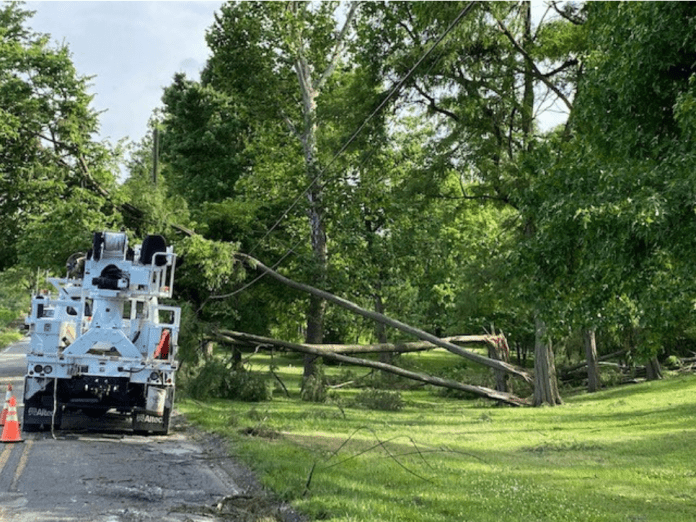Pro-ratepayer parties, including the state’s advocate-in-chief, oppose the deal.
AES Indiana slashed its $193-million base rate increase request by more than half — to $91 million — in a settlement agreement filed with state regulators on Wednesday.
“We have a deep commitment to operating efficiently and keeping rates as low as possible,” utility President Brandi Davis-Handy said in a news release. “Throughout this process, we’ve listened to stakeholder feedback and evaluated tradeoffs we will make for future investments while minimizing the financial impact of delivering safe and reliable electric service.”
The proposed deal is with Indiana University and the city of Indianapolis, plus a variety of companies: Allison Transmission, Eli Lilly & Co., Rolls-Royce, Walmart and more. Kroger wasn’t part of the deal but has no objection to it, according to the filing.
The matter is before the Indiana Utility Regulatory Commission, and won’t be decided until next year.
Indiana Utility Consumer Counselor Abby Gray and her office, as well as pro-ratepayer group Citizens Action Coalition, didn’t sign on.
“The settlement agreement filed by AES and other parties shows the utility’s initial request was inflated and unnecessary,” Gray said in a Thursday news release. “The OUCC stands by its initial recommendations for a reduction from current rates and will oppose the utility’s settlement agreement.”
Her office recommended last month that the IURC deny AES Indiana’s request — and, instead, said a $21 million cut to current rates is “warranted” based on the case‘s evidence and the law.
Citizens Action Coalition, meanwhile, called the proposal “unbalanced.”
“We will vigorously oppose this unfair and unaffordable deal and do everything we can to protect the residents of Indianapolis from yet another large utility bill increase,” Executive Director Kerwin Olson said in a Thursday news release. “Hoosiers have had enough with AES Indiana’s poor service, soaring bills, and backroom deals. It’s time for the IURC to send a message and restore affordability and accountability at our out-of-control monopoly utilities.
The proposed settlement
AES Indiana provides retail electric service to more than 530,000 residential, commercial and industrial customers in Indianapolis, as well as portions of other central Indiana communities surrounding Marion County
The agreement would lower the revenue requirement AES Indiana seeks from $2.1 billion to $2 billion, and lists other changes — to the cost of capital, fuel oil inventory, depreciation, vegetation management and more — that go into the revenue figure.
The utility also agreed not to implement new base rates arising out of its next case until 2030, after the current base rate request is carried out.
And the company would delay the start of its next proposed transmission, distribution and storage improvement charge plan until 2028. The current plan enters its final year in 2026.
“For over a decade, AES Indiana has consistently ranked among the lowest residential rates in the state, and that’s not by chance,” Davis-Handy said. “Despite rising costs, we have been disciplined in our planning through measures like our operations and maintenance costs holding flat for the past five years.”
Some of the agreement’s terms affect specific parties, like streetlight provisions involving the city of Indianapolis or discussions about “ways to ameliorate the peaks associated with Rolls-Royce’s engine testing.”
The document goes on to tackle the cost of service and rate design.
“The Settling Parties agree that rates should be designed in order to allocate the revenue requirement to and among AES Indiana’s customer classes in a fair and reasonable manner,” it reads.
The subsidy received by residential customers would be “mitigated” by 15%, according to the agreement. Fixed charges would stay at their current, regulator-approved levels: $12.50 monthly at 325 kilowatt hours or less, and $17 monthly for residents using more power.
Large secondary service customers would pay a $128 charge and a demand charge of $28.50.
Citizens Action Coalition said the deal would result in residential customers receiving a 6.51% base rate increase, whereas primary and secondary classes of large commercial and industrial customers would “only” receive a 3.19% and 4.12% increase, respectively.
The advocacy organization also critiqued the arrangement for “fail(ing) to adequately address” the “egregious and prolonged” problems tens of thousands of customers experienced after AES rolled out a new billing system in 2023.
Regulators can approve, deny, or modify any settlement agreement they consider. But the document says that — if the IURC doesn’t accept the proposed deal in its entirety — it’ll be null, void and withdrawn upon written notice of “unacceptable modifications” by any of the settling parties.
Data centers not part of the equation
AES Indiana also filed rebuttals this month to earlier criticisms.
In their response to the initial increase ask, OUCC witnesses labeled the utility “inattentive” and “indifferent” when it comes to affordability.
“While the OUCC may disagree with the Company on policy matters, the suggestion that differing viewpoints constitute wrongdoing should be rejected,” Davis-Handy said in her rebuttal.
She argued that AES Indiana can’t control much of the increase it seeks.
“Rate reviews are driven by facts and require sound analysis,” Davis-Handy said. “This is necessary because the price charged for retail electric service is underpinned by the cost incurred to provide the service, and the reality is that much of the cost incurred by the Company to provide service is outside the Company’s control.”
She pointed to the utility’s “relatively flat” non-fuel, non-labor operations and management expenses as proof of “reasonable and sound management of costs that are under the Company’s control.”
Davis-Handy also rejected claims that power-hungry data centers are behind the rate increase request, testifying that AES Indiana doesn’t have any data center customers right now and that data center load is “in no way associated with” the proposed hike.
The OUCC pledged to submit opposition testimony “on a future date to be determined.” The settlement agreement includes a request to change the case’s filing schedule, but notes the “non-settling parties” haven’t agreed to the revisions.
Parties will have the opportunity to file testimony in support or opposition to the deal, after which the IURC will hold an evidentiary hearing.
AES Indiana hopes regulators will finalize the case in the spring, so that it can implement new rates by June 1, 2026.
Correction: An earlier version of this article mistakenly described AES Indiana’s original base rate request as being for $293 million. However, it was for $193 million.





